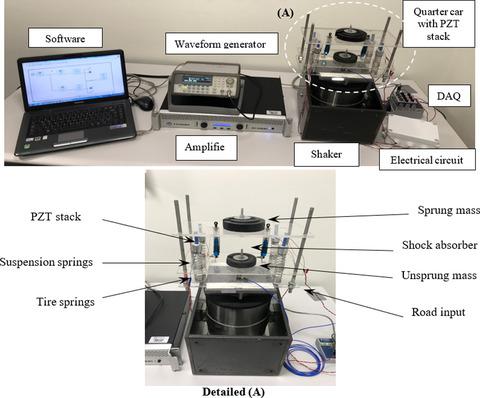当前位置:
X-MOL 学术
›
Energy Sci. Eng.
›
论文详情
Our official English website, www.x-mol.net, welcomes your
feedback! (Note: you will need to create a separate account there.)
Piezoelectric method‐based harvested energy evaluation from car suspension system: Simulation and experimental study
Energy Science & Engineering ( IF 3.5 ) Pub Date : 2020-11-02 , DOI: 10.1002/ese3.829 Tariq Darabseh 1, 2 , Doaa Al‐Yafeai 1 , Abdel‐Hamid I. Mourad 1, 3 , Fahad Almaskari 4
Energy Science & Engineering ( IF 3.5 ) Pub Date : 2020-11-02 , DOI: 10.1002/ese3.829 Tariq Darabseh 1, 2 , Doaa Al‐Yafeai 1 , Abdel‐Hamid I. Mourad 1, 3 , Fahad Almaskari 4
Affiliation

|
The main objective of this work is to build a mathematical model to evaluate the potential of harvesting power from the car suspension system. Quarter‐ and half‐car models with built‐in piezoelectric stack were modeled mathematically and simulated using MATLAB/Simulink. The piezoelectric stack was installed in series with the suspension spring to maintain the performance of the original car suspension system in ride quality and comfortability. The harvested voltage and power were tested with respect to time and frequency. From a half car model, the maximum generated voltage and power at the excitation frequency of 1.46 Hz were 33.56 V and 56.35 mW, respectively. By comparing a half‐car model with the quarter‐car model, the outcomes illustrated that the harvested voltage and power of the half‐car model were increased by 75.6% and 53.4%, respectively. Piezoelectric stack parameters (number of stack layers and area to thickness) and the car suspension parameters (sprung and unsprung stiffness, damping coefficients, and masses) were examined for half‐car model. Also, the influence of road amplitude unevenness was considered. The simulation results of the quarter‐car system were verified with the experimental test under harmonic excitation. The results exhibited good agreement with the simulation results at different excitation frequencies.
中文翻译:

汽车悬架系统基于压电方法的能量采集评估:仿真和实验研究
这项工作的主要目的是建立一个数学模型,以评估从汽车悬架系统获得动力的潜力。具有内置压电堆栈的四分之一和半汽车模型已通过数学建模,并使用MATLAB / Simulink进行了仿真。压电叠层与悬架弹簧串联安装,以保持原始汽车悬架系统在行驶质量和舒适性方面的性能。相对于时间和频率测试收获的电压和功率。在半车模型中,在1.46 Hz激励频率下的最大产生电压和功率分别为33.56 V和56.35 mW。通过将半车模型与四分之一车模型进行比较,结果表明,半车模型的收获电压和功率分别增加了75.6%和53.4%,分别。对于半车模型,检查了压电堆栈参数(堆栈层数和面积与厚度)和轿厢悬架参数(簧上和簧下刚度,阻尼系数和质量)。另外,考虑了道路振幅不均的影响。在谐波激励下,通过实验测试验证了四分之一车系统的仿真结果。结果与不同激励频率下的仿真结果吻合良好。在谐波激励下,通过实验测试验证了四分之一车系统的仿真结果。结果与不同激励频率下的仿真结果吻合良好。在谐波激励下,通过实验测试验证了四分之一车系统的仿真结果。结果与不同激励频率下的仿真结果吻合良好。
更新日期:2020-11-02
中文翻译:

汽车悬架系统基于压电方法的能量采集评估:仿真和实验研究
这项工作的主要目的是建立一个数学模型,以评估从汽车悬架系统获得动力的潜力。具有内置压电堆栈的四分之一和半汽车模型已通过数学建模,并使用MATLAB / Simulink进行了仿真。压电叠层与悬架弹簧串联安装,以保持原始汽车悬架系统在行驶质量和舒适性方面的性能。相对于时间和频率测试收获的电压和功率。在半车模型中,在1.46 Hz激励频率下的最大产生电压和功率分别为33.56 V和56.35 mW。通过将半车模型与四分之一车模型进行比较,结果表明,半车模型的收获电压和功率分别增加了75.6%和53.4%,分别。对于半车模型,检查了压电堆栈参数(堆栈层数和面积与厚度)和轿厢悬架参数(簧上和簧下刚度,阻尼系数和质量)。另外,考虑了道路振幅不均的影响。在谐波激励下,通过实验测试验证了四分之一车系统的仿真结果。结果与不同激励频率下的仿真结果吻合良好。在谐波激励下,通过实验测试验证了四分之一车系统的仿真结果。结果与不同激励频率下的仿真结果吻合良好。在谐波激励下,通过实验测试验证了四分之一车系统的仿真结果。结果与不同激励频率下的仿真结果吻合良好。











































 京公网安备 11010802027423号
京公网安备 11010802027423号